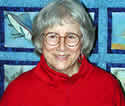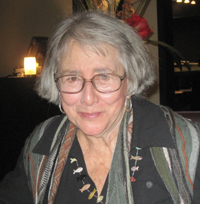
May 18, 2012

Eugenie Clark (1922 – ) served on the board of directors of the now-defunct International Society of Cryptozoology (ISC), and continues to maintain an interest in ichthyological cryptids and mysteries.
A well-known diver and scientist, Clark has explored the underwater world of many seas. She became famous through a popular series of Scholastic paperback books, Shark Lady: True Story of Eugenie Clark, Lady with a Spear, Further Adventures of Shark Lady Eugenie Clark, and The Desert Beneath the Sea, often done by or with her frequent diving companion Ann McGovern.
Among many biographies published about Eugenie Clark today, an early critic’s favorite for youth was Eugenie Clark and the Sleeping Sharks.
Clark’s many adventures include diving into caves in Mexico to study “sleeping” sharks, discovering a Red Sea fish that keeps large sharks away, and proving that sharks have intelligence and good memory.
Intriguingly, Clark’s interest in the oceans did not come from living seaside. She was born and raised in New York City. Her interest in fish began when she was nine years old and visited the aquarium.
Clark’s involvement with cryptozoology goes back decades. She maintains a passionate interest in discoveries of new species of fish.
The following fishes have been named after Clark:
1978 Callogobius clarki (Goren) – Family Gobiidae
1980 Sticharium clarkae (George and Springer) – Family Clinidae
1982 Enneapterygius clarkae (Holleman) – Family Tripterygiidae
1987 Atrobucca geniae (Ben-Tuvia and Trewavas) – Family Scienidae,
Clark is a professor emerita and senior research scientist in the Department of Zoology at the University of Maryland. A world-famous ichthyologist who began her studies on the behavior and reproductive isolating mechanisms of fresh-water aquarium fishes, Clark later combined her love for diving with the study of marine fishes: first hard-hat diving and snorkeling, then using scuba and submersibles, including ROVs. Clark studied shark behavior in the deep sea from submersibles at depths of 1,000 to 12,000 feet, conducting 71 dives off Grand Cayman, Bermuda, the Bahamas, California, and Japan to study the behavior, movements, and population density of large deep sea fishes.

Noncryptozoological, mainstream descriptions of Eugenie Clark’s life is found here and here.
Eugenie Clark is so well-known, she has had a building named after her in 1988, the Eugenie Clark Home Room building at the Pine View Elementary School, Sarasota, Florida.
Nevertheless, one does not have to dive too deeply to discover cryptozoology surfaced during her university days. During her active teaching at the University of Maryland College Park, she taught Zoology 299A, “Sea Monsters and Deep Sea Sharks,” seven semesters from 1991-1999 to between 111 to 191 students, as well as Honors 128, “Sea Monsters and Deep Sea Sharks,” 1991-96, to 25 to 59 students and Honors 228, “Sea Monsters and Deep Sea Sharks,” 1991-1999, to 20 students.
Clark’s scientific writings began in 1947, with, “Notes on the inflating mechanism of the swell shark, Cephaloscyllium uter,” in Copeia, No. 4: 278-280. Besides Clark’s involvement with the ISC’s publication Cryptozoology, she also is listed as one of the coauthors (Pierce, S.K., Smith, G.N., Clark, E. and Maugel, T.) in 1994, for the article, “On the giant octopus (Octopus giganteus) and the Bermuda blob: homage to A.E. Verrill,” in Biological Bulletin, 188: 219-230.

Professor Eugenie Clark was a member of the faculty of the Department of Biology (then Zoology) from 1968 until her retirement in 1992. During her time at Maryland Dr. Clark was known as an outstanding teacher of marine biology and an exceptional mentor.
Dr. Clark is internationally known as the “shark lady” because of her pioneering work on the behavior of sharks. She received her doctorate from New York University in the late 1940s. In 1953 she published an autobiography “Lady With a Spear” that became an international best seller for over a year. The book has influenced generations of young people to consider careers in science in general and marine biology in particular. Several other books by or about Dr. Clark have also been best sellers, and the 1998 book by Ann McGovern “Adventures of the Shark Lady: Eugenie Clark Around the World,” was the best selling book every published by Scholastic Book Services until they published “Harry Potter.”
During her long and very distinguished career Dr. Clark published numerous scientific papers, over 12 articles about her research in National Georgraphic Magazine, was instrumental (along with her friend Anwar Sadat) in founding the Ras Muhammad underwater national park in Egypt, and conducted research all over the world (and she continues doing that to this day).
Dr. Clark founded the Cape Haze Marine Laboratory in Sarasota Florida (now the Mote Marine Laboratory). Her many honors include three honorary degrees, an Emmy Award, being named honorary director of the Explorer’s Club, having four different fish species named for her, and she has been the recipient of numerous awards from US and international organizations for her contributions to science and for her exceptional ability to communicate science to the public. Indeed, one of Dr. Clark’s greatest contributions has been her unique ability to share her excitement of and about science with audiences that range from grade school children to senior scientists. For this truly important contribution as a scholar, Dr. Clark received the President’s Medal from the University of Maryland in 1993.
Her extensive resume (current to 1999) is visible online here.
Clark has four children, named Hera, Aya, Tak and Niki Konstantinou.
Her daughter Hera Konstantinou continues the family’s diving tradition and watery links. Hera Konstantinou is a member of the faculty at the Department of Wildlife & Fisheries Sciences, Texas A&M University, and openly maintains an interest in Mermaids.
About Loren Coleman
Loren Coleman is one of the world’s leading cryptozoologists, some say “the” leading living cryptozoologist. Certainly, he is acknowledged as the current living American researcher and writer who has most popularized cryptozoology in the late 20th and early 21st centuries.
Starting his fieldwork and investigations in 1960, after traveling and trekking extensively in pursuit of cryptozoological mysteries, Coleman began writing to share his experiences in 1969. An honorary member of Ivan T. Sanderson’s Society for the Investigation of the Unexplained in the 1970s, Coleman has been bestowed with similar honorary memberships of the North Idaho College Cryptozoology Club in 1983, and in subsequent years, that of the British Columbia Scientific Cryptozoology Club, CryptoSafari International, and other international organizations. He was also a Life Member and Benefactor of the International Society of Cryptozoology (now-defunct).
Loren Coleman’s daily blog, as a member of the Cryptomundo Team, served as an ongoing avenue of communication for the ever-growing body of cryptozoo news from 2005 through 2013. He returned as an infrequent contributor beginning Halloween week of 2015.
Coleman is the founder in 2003, and current director of the International Cryptozoology Museum in Portland, Maine.
Filed under Books, Breaking News, Cryptomundo Exclusive, Cryptotourism, CryptoZoo News, Cryptozoologists, Cryptozoology, Expedition Reports, New Species, Sea Serpents